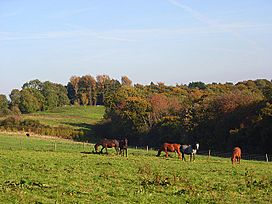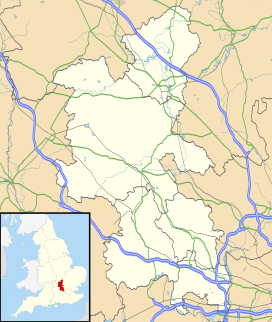Bottom Wood facts for kids
Quick facts for kids Bottom Wood |
|
|---|---|

Bottom Wood from an adjacent hillside
|
|
| Map | |
| Geography | |
| Location | Buckinghamshire, England |
| OS grid | SU795950 |
| Coordinates | 51°39′14″N 0°51′04″W / 51.654°N 0.851°W |
| Area | 14.5 hectares (36 acres) |
Bottom Wood is a 14.5-hectare (36-acre) woodland in Buckinghamshire, England. It is located near the village of Studley Green. Since 1984, the Chiltern Society has owned this wood. They manage it as a special nature reserve with the help of volunteers.
Even though it is an ancient woodland, most of the trees you see today grew after the 1940s. This is because many trees were cut down during the Second World War. The wood was used to make matches for a company called Bryant and May. Today, Bottom Wood is home to many different plants and animals. This includes some rare types of butterfly and moth.
Contents
Where is Bottom Wood?
Bottom Wood is north of the A40 road, between Piddington and Stokenchurch. It is also north-east of Studley Green. The wood is part of the Radnage area. Its southern edge meets the border of Stokenchurch, and its eastern edge meets West Wycombe. The southern border of the wood used to be the line between Buckinghamshire and Oxfordshire counties. This changed in 1896.
The wood sits in a valley, with trees growing on the south-facing slope. The land goes from 132 metres (433 ft) to 162 metres (531 ft) above sea level. The wood is shaped like a crescent moon and covers 14.5 hectares (36 acres). The older part of the wood is 11.5 hectares (28 acres). There is also a newer planted area of 3 hectares (7 acres) called Toothill. The name Toothill comes from an old English word meaning 'look-out'. From the top of Toothill, you can get a great view across the valley. The ground under the wood is mostly chalk, with some clay and sand, which is common in the Chilterns area.
A bridleway runs through the middle of the wood. This path was once used by packhorses carrying goods between Piddington and Oxford. Now, a sewer pipe runs underground along this old path.
A Look at Bottom Wood's Past
The main part of Bottom Wood is an ancient woodland. This means it has been a wooded area for a very long time, possibly for hundreds of years. Old documents from the Middle Ages show that a French abbey owned the land from the 1100s until 1413. After that, the land was returned to the King or Queen. Over the years, the wood was owned by many different people and families. In 1737, John Scrope, who owned Wormsley Park, bought the wood. It stayed part of his estate until the 1930s.
The first time the name "Bottom Wood" was written down was on a map in 1841. Back then, the eastern part of the wood was called Dean Hook. In the early 1900s, timber from Bottom Wood was sold every year. You can still find signs of old saw pits in the wood. These were places where trees were cut into planks.
During a very dry period in 1921, a well in the wood became very important. It gave drinking water to local villagers when their own water supplies ran out. This well is 30 metres (98 ft) deep and always had water, even during droughts. Today, the well is covered with concrete.
In the mid-1930s, Mr. Pitcher bought the wood. During the Second World War, many trees in the wood were cut down. They were used to make matches for Bryant and May. Because of this, most of the trees you see today grew after the late 1940s. Only a few older trees remain in the northern part of the wood. After the war, new trees like cherry, beech, and oak started to grow back.
In the 1950s, Mr. Pitcher sold the wood to Mr. Deane. With help from local scouts, Mr. Deane planted the nearby field of Toothill. He planted Sitka spruce and Scots pine trees there. He also added some Douglas firs to the eastern edge of the wood. Later, Mrs. Ercolani bought the wood. She tried to manage it as a nature reserve, but much of the wood became overgrown and damaged during this time.
"We entered the wood from the Beacon's Bottom end. It was very scrubby with collapsing hazel and thorns with a bit of rubbish, including the remains of an old car at the entrance...The old beech wood was very dark with almost no ground vegetation. Lads on scramble bikes had worn a track up and down the hill over the old strip field system".
In 1984, the wood was given to the Chiltern Society. This group had just started a project to help small woodlands in the Chilterns area. Bottom Wood was chosen as a place to teach people how to manage woodlands well. The project had three main goals: to help native trees grow, to make the trees healthier, and to manage the wood as a nature reserve.
A small team from the Chiltern Society started working in the wood in September 1983. They spent ten weeks clearing the bridleway and removing rubbish. They also cut down some trees to help healthier ones grow. They cleared 0.5 hectares (1.2 acres) of the Toothill area and planted 350 new trees. These new trees were mostly ash, cherry, beech, and whitebeam. Volunteers continued to improve the wood in the years that followed. Some of the timber they cut was sold to local businesses to help pay for the management work. More trees were selectively cut down, including in 1989. A central part of Toothill, 0.5 hectares (1.2 acres) in size, was left open to create a chalky grassland area.
Bottom Wood Today
Bottom Wood is still owned by the Chiltern Society. Volunteers from the Society's Bottom Wood Group manage it as a nature reserve. It is open to everyone. You can get to it from Old Dashwood Hill in Studley Green, and there is some parking available on the road. Since 2010, Mary Towerton School has used the wood for a forest school program. This program helps children learn about nature outdoors.
Amazing Wildlife
Bottom Wood is a very rich environment. It is home to over 700 different kinds of plants and animals. Scientists have studied many of these species. For example, a student researched the plants, and a record of moths has been kept since 1993.
Plants in the Wood
Bottom Wood has many different plants. This is because the soil has different levels of acidity and moisture. Some rare plants found here include coral-root bittercress and yellow bird's-nest. The wood is especially famous for its beautiful bluebells. The main type of shrub growing here is hazel. You can also find many kinds of trees, like cherry, oak, ash, beech, yew, and hornbeam.
Animals in the Wood
At least 25 different types of butterfly live in the wood. They are often seen in the open grassland area of Toothill. Three rare species have been spotted: the grizzled skipper, the small blue, and the white-letter hairstreak. The Duke of Burgundy butterfly was also seen here in 1989.
The wood is home to 251 different moth species. Five of these are considered 'nationally notable b'. This means they have been found in less than 4% of Great Britain. These special moths are Drepana cultraria, Paradarisa consonaria, Paradarisa extersaria, Cerastis leucographa, and Lithophane hepatica.
Dormice live in the wood and are carefully watched because they are a protected species. You can often see red kites flying in the area. Other rare birds like lesser spotted woodpeckers and marsh tits are also present. A red deer was once seen in the wood too.
Like other woodlands in the Chilterns, trees in Bottom Wood have been damaged by grey squirrels. They sometimes strip the bark from trees. To help protect the trees, measures are in place to control the squirrel population.
Images for kids



